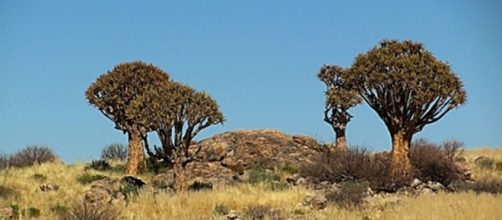Not far from Cape Town, on the road to Namibia, the magnificent mountains shelved out to meadows of fynbos. Scores of birds adorned the wetlands and robust orchards hung their fruit for the picking. We stopped for tea in Citrusdal where the tangy smell of oranges blew in on warm breezes.
Half an hour later we passed through Clanwilliam, a town in the heart of the Rooibos Tea industry and decided to deviate to Graafwater which is a small village with a rooibos tea factory. We bought big boxes of rooibos and the fragrance of the tea kept the car smelling nice as we continued on our way.
It was peaceful and quiet away from the main N7 route, so we stayed on the rural roads, for most of the day pushing slowly north towards the semi-desert. We picked up the N7 again at Nuwerus but meandered off here and there.
We stopped over in Garies for the night at a charming Bed and Breakfast set about with camel thorn and brightly painted bougainvillea. Early the next morning we were on the road to Springbok the capital of the Namakwa District Municipality which lies in a narrow valley between great granite domes.
The flat dry land was becoming hot and the distances stretched out in all directions. We pushed on to the border post at Vioolsdrift, which squats next to the brown and sluggish Orange River.
We had met this river before, away up in the highlands of Lesotho. The people of Lesotho call it the Senqu River. We cleared through the border and stopped on the Namibian side to clear customs
Immediately across the Orange River, as if the great flow of water had drawn a line in the sand the desert began. For a while, we drove through a lunar landscape.
There were no pretty flowers or camel thorns, no shade, not even any sand. There were only hills of rock interspersed with fields of rock. Brown, harsh and hard rock was backlit by the white-blue of the hot sun.
We entered the Karas region of Namibia and found ourselves at Keetmanshoop in the afternoon. Keetmanshoop is in a semi-arid area, which only gets on average 150 mm of rain a year, but there were some grass and some small shrubs.
This was my first visit to a Namibian town, I was impressed by the simplicity, and Beauty of cut stone buildings set in the dry and dusty veld. Our overnight stop was close to Keetmanshoop at the Quiver Tree Forest. We had only ever seen Quiver trees in books before, so we were anxious to spend some time at the camp and explore.
The camp was plain and unadorned but the austerity of it seemed to fit in with the simple fact that here was a desert. The uncluttered countryside did not need adornments to make it attractive. It had its very own desolate beauty. We ambled through the quiver trees. They are a type of aloe, which looked remarkably similar to the New Zealand Cabbage Trees we had seen on the west coast.
The trees stood clustered round about amongst balancing rocks in dolomite country.
There were stunning photo opportunities amongst the aloe trees in the forest. We consulted our little brochure which informed us that some are them are estimated to be between 200 and 300 years old. Quiver trees get their name from the early Bushmen, who used the bark to make their quivers.
After we had explored the Quiver tree forest, it was time for us to push on to Windhoek. The road was excellent, passing through Rehoboth, and a few hours later the small and pristine town of Windhoek lay below us like a coloured handkerchief in the veld.
The Elisenhiem campsite on the far western edges of the town was a good fifteen minutes’ drive from the city centre, so we went to stock up at the shopping centre.
Incredibly, we found a huge mall. It could have been any mall in South Africa but it was much cleaner and still very new. All the major chain stores were there.
Cold beer, steals on the fire and leopards grunting in the African night – who could ask for more?

